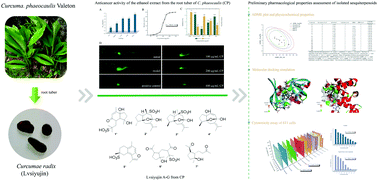Lvsiyujins A–G, new sesquiterpenoids, from Curcuma phaeocaulis Valeton root tuber and their preliminary pharmacological property assessment based on ADME evaluation, molecular docking and in vitro experiments†
Abstract
The ethanol extract from the root tuber of Curcuma phaeocaulis Valeton (CP), a well-known traditional Chinese medicine named Curcumae radix, exhibited excellent anticancer activity in in vitro cytotoxic assay and in vivo zebrafish xenograft experiments. Seven new sesquiterpenoids, lvsiyujins A–G (1–7), and nine known compounds (8–16) were isolated from CP. The structures of new compounds were elucidated by HRMS data, NMR spectroscopic data, electronic circular dichroism (ECD), computer-assisted structure elucidation methods, quantum chemical calculations and literature studies. Lvsiyujin A (1) had an unusual 5/6 sesquiterpenoid skeleton and lvsiyujin G (7) had a C12 skeleton, both of which are rarely found in the Curcuma genus. Sulfonic acid groups, which were seldom seen in sesquiterpenoids, appeared in lvsiyujins A, B, C, E, and F (1, 2, 3, 5, and 6). Their plausible biogenetic pathways were hypothesized according to chemical structures and literature studies. These isolated compounds displayed great potential in the evaluation of drug-like properties through physicochemical property assessment and ADME profiling and showed high affinity to target proteins of breast cancer in molecular docking. Interestingly, the subsequent cytotoxicity assay showed that among these compounds only compounds 5, 8, 9, and 16 could inhibit the proliferation of 4T1 cells when administered alone, while the activity of the equal mixture was significantly better than that of these compounds alone. These findings suggested that CP has potential for breast cancer resistance, and its anti-breast cancer activity may be due to the synergistic effect of sesquiterpenoids.



 Please wait while we load your content...
Please wait while we load your content...